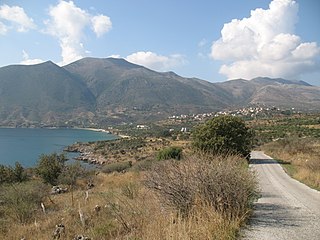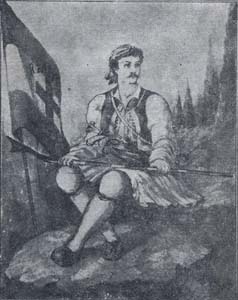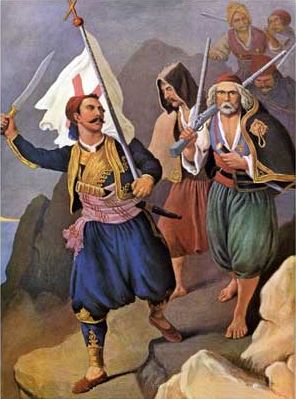Prelude
The failed Orlov Revolt had been a disaster for Mani and in 1770, the Ottoman pasha of the Peloponnese, Hassan Ghazi, invaded Mani with a large force of Turco-Albanians. Their army laid siege to the Grigorakis tower in Skoutari which was garrisoned by fifteen men. The tower held out for three days until it was undermined and gunpowder was placed underneath the tower which was then set alight and blown up.
The Ottomans then advanced to the plain of 'Vromopidaga' where they defeated by the vastly outnumbered Maniots. Ghazi then lured the Maniots' leader Exarchos and had him hung. His mother then had the men of Skoutari under Grigorakis trick the Turkish garrison at Passavas and sacked the city.
In 1784, Grigorakis was lured onto an Ottoman ship and was given the choice of his life or to accept the title of bey and Ottoman vassalage. For four years since the last Ottoman invasion, Grigorakis had refused offers to become bey but under the pressure of this threat he accepted. But in 1798 he was caught conspiring with French agents. He was disposed and outlawed but he continued to cause trouble for the Ottomans from his tower house at Marathonisi. In 1803, a load of French weapons was delivered to his fort. Once the Ottomans found out, they decided it was time to stop Grigorakis.

The Mani Peninsula, also long known by its medieval name Maina or Maïna, is a geographical and cultural region in the Peloponnese of Southern Greece and home to the Maniots, who claim descent from the ancient Spartans. The capital city of Mani is Areopoli. Mani is the central of three peninsulas which extend southwards from the Peloponnese. To the east is the Laconian Gulf, to the west the Messenian Gulf. The Mani peninsula forms a continuation of the Taygetos mountain range, the western spine of the Peloponnese.

The Great Turkish War or The Last Crusade, also called in Ottoman sources The Disaster Years, was a series of conflicts between the Ottoman Empire and the Holy League consisting of the Holy Roman Empire, Poland-Lithuania, Venice, Russia, and the Kingdom of Hungary. Intensive fighting began in 1683 and ended with the signing of the Treaty of Karlowitz in 1699. The war was a resounding defeat for the Ottoman Empire, which for the first time lost substantial territory, in Hungary and the Polish–Lithuanian Commonwealth, as well as in part of the western Balkans. The war was significant also for being the first instance of Russia joining an alliance with Western Europe. Historians have labeled the war as the Fourteenth Crusade launched against the Turks by the papacy.

Skoutari is a village and a community of the municipality of East Mani. Before the 2011 local government reform it was a part of the municipality of Gytheio, of which it was a municipal district. The community of Skoutari covers an area of 11.667 km2. According to local tradition it was founded by refugees from the Fall of Constantinople in 1453.

The Battle of Vromopigada was fought between the Ottoman Turks and the Maniots of Mani in 1770. The location of the battle was in a plain between the two towns of Skoutari and Parasyros. The battle ended in a Greek victory.

The Ottoman–Egyptian invasion of Mani was a campaign during the Greek War of Independence that consisted of three battles. The Maniots fought against a combined Egyptian and Ottoman army under the command of Ibrahim Pasha of Egypt.

The Maniots or Maniates are an ethnic Greek subgroup that traditionally inhabit the Mani Peninsula; located in western Laconia and eastern Messenia, in the southern Peloponnese, Greece. They were also formerly known as Mainotes, and the peninsula as Maina.

Vatheia is a village on the Mani Peninsula, in south-eastern Laconia. The local community of Vatheia is named after this village. The aforementioned local community is a subdivision of the municipal unit of Oitylo. It is known for its tower-houses built on a hill dominating the surrounding countryside.

The 1770 Ottoman invasion of Mani was one of a series of invasions by the Ottomans to subdue the Maniots. Mani was one region of Greece that the Ottomans had not occupied due to the rough terrain and the rebellious spirit of Maniots. The Maniots caused damage to the Ottomans by allying with the Venetians whenever there was a war between Venice and the Ottomans, and also habitually engaged in piracy.

The 1815 Ottoman Invasion of Mani was one of a series of invasions by the Ottomans to subdue the Maniots. Mani was the only region of Greece that the Ottomans had not occupied due to the rough terrain and the rebellious spirit of the Maniots. The Maniots caused damage to the Ottomans by allying with the Venetians whenever there was a war between Venice and the Ottomans. They also practiced piracy.

The 1807 Ottoman Invasion of Mani was one of a series of invasions by the Ottomans to subdue the Maniots. Mani was the only region of Greece that the Ottomans had not occupied due to the rough terrain and the rebellious spirit of the Maniots. The Maniots caused damage to the Ottomans by allying with the Venetians whenever there was a war between Venice and the Ottomans; they also were pirates.
The siege of Kastania was fought in July 1780 between the Maniots and the klephts under Konstantinos Kolokotronis and Panagiotaros Venetsakis and the Ottoman Empire under Ali Bey.

Zacharias Pantelakos, nicknamed Barbitsiotis but more commonly known as Kapetan Zacharias, was a Greek klepht in the Peloponnese during the last decades of Ottoman rule over Greece. He is described by Kyriakos Kassis as the best klepht of Taygetus.

The Morean war, also known as the Sixth Ottoman–Venetian War, was fought between 1684–1699 as part of the wider conflict known as the "Great Turkish War", between the Republic of Venice and the Ottoman Empire. Military operations ranged from Dalmatia to the Aegean Sea, but the war's major campaign was the Venetian conquest of the Morea (Peloponnese) peninsula in southern Greece. On the Venetian side, the war was fought to avenge the loss of Crete in the Cretan War (1645–1669). It happened while the Ottomans were entangled in their northern struggle against the Habsburgs – beginning with the failed Ottoman attempt to conquer Vienna and ending with the Habsburgs gaining Buda and the whole of Hungary, leaving the Ottoman Empire unable to concentrate its forces against the Venetians. As such, the Morean War was the only Ottoman–Venetian conflict from which Venice emerged victorious, gaining significant territory. Venice's expansionist revival would be short-lived, as its gains would be reversed by the Ottomans in 1718.

Liverios Gerakaris, more commonly known by the hypocoristic Limberakis, was a Maniot pirate who later became Bey of Mani.

The Liberation of Kalamata took place on 23 March (O.S.) 1821 when Greek irregular revolutionary forces took control of the city after the surrender of the Ottoman garrison, without fighting. It was one of the first events of the Greek War of Independence. Kalamata became the first major town to be liberated.
Konstantinos Kolokotronis was a notable Greek klepht leader in the third quarter of the 18th century in the Peloponnese, and the father of Theodoros Kolokotronis, one of the leaders of the Greek War of Independence.

The siege of Coron was the capture of the Ottoman fortress of Coron (Koroni) in the southwestern Morea (Peloponnese) by the Republic of Venice in 1685. It signalled the start of the Venetian conquest of the Morea during the Great Turkish War. Along with neighbouring Modon (Methoni), Coron had been strategically important Venetian bases until captured by the Ottomans in 1500. When Venice declared war on the Ottomans in 1684, the Venetian commander-in-chief, Francesco Morosini, quickly set his sights on a conquest of the Morea as a revenge and recompense for the recent loss of Crete. In this he hoped to have the assistance of the Maniots, a semi-autonomous and restive population that resisted Ottoman authority. However, the Ottomans pre-empted the Venetians by invading the Mani Peninsula and garrisoning its fortresses. Rather than land at Mani, therefore, Morosini chose to target Coron, securing for himself a base of operations and encouraging the Maniots to rise up by a display of military might. The Venetian forces began the siege on 25 June by digging trenches to isolate the citadel of Coron from the landward side, and began a bombardment from both land and sea. An Ottoman relief army, under the governor of the Morea, Halil Pasha, soon arrived, and a month of bloody fighting began between the Venetians and the Ottoman relief army, all the while attempts to breach the citadel walls continued. The decisive combat took place on 7 August, when the Venetian lines were broken through; a counterattack at dawn however threw the Ottomans back and dispersed their army. Free to focus on the siege, the Venetians launched a major assault on 11 August, forcing the fortress to surrender. During the negotiations, the accidental explosion of a cannon led to the massacre of the garrison due to fears of treachery. With Coron secured, the Venetians moved towards Mani, which rose in revolt. A major victory over another Ottoman army followed at the Battle of Kalamata, and the conquest of Messenia was completed in the next year with the capture of New Navarino fortress and Modon.
The Greek Legion, officially the Light Jäger Foot Legion, was a Jäger infantry unit in the service of the Russian-controlled Septinsular Republic. It consisted of soldiers of Greek and Albanian origin and was led by Major-General Emmanouil Papadopoulos. It was active between 1805 and 1807, taking part in the War of the Third Coalition and the Russo-Turkish War (1806–1812).
Tzanetos "Kapetanakis" Grigorakis, also known as Zanetos or Tzanibey or Zanibey or Tzanetbey or Zanetbey, was a Greek politician, military leader and the third bey of Mani, the most prominent together with Petrobey Mavromichalis. He was the longest-ruling bey of the Maniots, serving for 16 years, from 1782 to 1798.

The Battle of Kalamata took place on 14 September 1685 between the expeditionary army of the Republic of Venice in the Morea, led by Hannibal von Degenfeld, and the forces of the Ottoman Empire, led by the Kapudan Pasha. The battle ended in a Venetian victory, which allowed the Venetians to complete the conquest of the Mani Peninsula, solidifying their foothold in the southern Morea.












